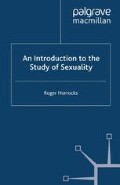Abstract
Amidst the contemporary ferment in the study of gender and sexuality, male sexuality remains something of an enigma, and is surprisingly under-researched. Yet in political terms, it is also easy to understand why this should be so, since traditional conceptions of sex and sexuality have been dominated by the male heterosexual viewpoint. Hence most radical critics and researchers have tended to steer clear of this area, or have taken up quite negative standpoints towards ‘masculinist heterosexism’.
Access this chapter
Tax calculation will be finalised at checkout
Purchases are for personal use only
Preview
Unable to display preview. Download preview PDF.
Notes
Mary Daly, Pure Lust: Elemental Feminist Philosophy (London: Women’s Press, 1984), p. 2.
R. v. Krafft-Ebbing, Aberrations of Sexual Life: The Psychopathia Sex-ualis (London: Panther, 1965), p. 25.
D.H. Lawrence, Lady Chatterley’s Lover (Harmondsworth: Penguin, 1961), p. 120–1.
See David H.J. Morgan, Discovering Men (London and New York: Routledge, 1992), chapters 4–6;
Jeff Hearn, Men in the Public Eye: The Construction and Deconstruction of Public Men and Public Patriarchies (London and New York: Routledge, 1992).
On sport, see R. Horrocks, Male Myths and Icons, chapter 9; on criminality, see T. Newburn and E. A. Stanko (eds), Just Boys Doing Business: Men, Masculinities and Crime (London: Routledge, 1994); on men and feminism, see
Lynne Segal, Slow Motion: Changing Masculinities, Changing Men (London: Virago, 1990).
See R.J. Stoller, Presentations of Gender (New Haven and London: Yale University Press, 1985);
David Gilmore, Manhood in the Making: Cultural Concepts of Masculinity (New Haven and London: Yale University Press, 1990).
Evangeline Kane, Recovering from Incest: Imagination and the Healing Process (Boston: Sigo, 1989), pp. 48 ff.
Edith Wharton, The Age of Innocence (Harmondsworth: Penguin, 1984), pp. 83–4.
Jane Austen, Persuasion (Harmondsworth: Penguin, 1965), p. 250.
Jane Austen, Emma (Harmondsworth: Penguin, 1966), p. 12.
See Vic Seidler, ‘Tear and intimacy’, in Andy Metcalf and Martin Humphries (eds), The Sexuality of Men (London: Pluto, 1990), pp. 150–80.
Editor information
Copyright information
© 1997 Roger Horrocks
About this chapter
Cite this chapter
Horrocks, R. (1997). Male Sexuality. In: Campling, J. (eds) An Introduction to the Study of Sexuality. Palgrave Macmillan, London. https://doi.org/10.1057/9780230390140_10
Download citation
DOI: https://doi.org/10.1057/9780230390140_10
Publisher Name: Palgrave Macmillan, London
Print ISBN: 978-0-333-65139-1
Online ISBN: 978-0-230-39014-0
eBook Packages: Palgrave Social & Cultural Studies CollectionSocial Sciences (R0)

